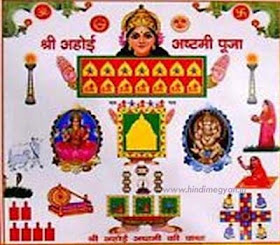What is Ahoi Fast: This fast is observed by mothers for the well being of their sons. This fast is more popular in North India.
The fast might look little discriminatory because it is not being observed for the daughters. The reason for this is in olden times, females mostly used to stay indoors and men used to go out for earning money so there was more risk to the life of male members from wild animals, wars, natural calamities, bandits etc. Hence this fast was observed to make their life safe. These days many women observe this fast for their daughters as well. The fast is broken after the sighting of stars in the evening.
This fast falls 4 days after Karwa Chauth and 8 days before Diwali. It falls on 31st October 2018 this year.
How to Observe the Fast:
On the day of fasting, after taking morning bath women take a pledge, called Sankalp, to keep the fast for the well being of their children. It is also recited during Sankalp that the fasting would be without any food or the water and the fast would be broken after sighting the stars or the moon according to their family tradition.
Puja preparations are finished before sunset. Women either draw the image of Goddess Ahoi on the wall using geru or embroider it on a piece of cloth and hang it on a wall. Any image of Ahoi Mata used for the puja should have Ashtha Koshthak i.e. eight corners due to the festival being associated with Ashtami Tithi. The image includes along with Goddess Ahoi, the images of and young children and Syahu (i.e. a porcupine).
Then, the place of worship is sanctified with holy water and Alpana is drawn. After spreading wheat on the floor or on the wooden stool, one water-filled kalash (pot) is kept at the place of worship. The mouth of the Kalash is covered with an earthen lid.
A small earthen pot, preferably Karwa is kept on the top of the Kalash. Karwa is filled with the water and covered with its lid. The nozzle of the Karwa is blocked with the shoots of the grass. The commonly used shoot is known as Sarai Seenka which is a type of willow. The seven shoots of the grass are also offered to Ahoi Mata and syahu. The shoot of Sarai is sold during the festival especially in the small towns of India. If grass shoots are not available then cotton buds can be used.
The food items which are used in Puja include 8 Puri, 8 Pua and Halwa. These food items are given to a Brahmin along with some money.
There are many tales related to this observance and one of them is told just after the puja is done as part of the ritual.
Original Tale:
Once upon a time, there lived a moneylender who had seven sons. One day in the month of Kartik, just a few days before Diwali festivities, the moneylender's wife decided to repair and decorate her house for Diwali celebrations. To renovate her house, she decided to go to the forest to fetch some soil. While digging the soil in the forest, she accidentally kills the young one of a porcupine with the spade with which she was digging the soil. The animal then curses her to a similar fate and within a year all her 7 children die.
The couple unable to tolerate the grief decide to kill themselves en route to a final pilgrimage. They keep walking till they no longer able to and fall unconscious on the ground. God, on seeing this, feels pitiful for then and makes an Akashvani asking them to go back, serve the holy cow and worship Goddess Ahoi as she was believed to be the protector of the offspring of all living beings. The couple feeling much better, return home.
They follow the divine command. When the day of Ashtami came, the wife drew the face of the young porcupine and observed fast and performed Goddess Ahoi. She honestly repented for the sin which she had committed. Goddess Ahoi was pleased with her devotion and honesty and appeared before her and gave her the boon of fertility.
अहोई व्रत या अहोई अष्टमी क्या है। :
यह व्रत माताओं द्वारा अपने पुत्रों की रक्षा एवं दीर्घायु के लिए रखा जाता है। यह उत्तर भारत में ज़्यादा प्रसिद्द है।
ऐसा महसूस हो सकता है की इस व्रत में पुत्र और पुत्रियों के बीच में भेदभाव किया जा रहा है। लेकिन ऐसा नहीं है इस व्रत का पुत्रों के लिए रखे जाने का मकसद यह था कि पुराने समय में घर की औरतें ज्यादा बाहर नहीं निकलती थी इस वजह से उनके जीवन को कम खतरा था बजाय की पुरुषों के जो कि कमाने के लिए ज्यादातर समय घर के बाहर रहते थे। इस वजह से डाकुओं, युद्ध, आक्रमण इत्यादि से उनकी रक्षा करने के लिए माताएं पुत्रों की रक्षा के लिए यह व्रत रखती थी। लेकिन आजकल माताएं अपनी पुत्रियों के लिए भी यह व्रत रखती हैं। रात में तारों को देख कर ही इस व्रत को तोड़ा जाता है। इस साल अहोई अष्टमी 31 अक्तूबर 2018 को पड़ेगी।
व्रत कैसे करें:
व्रत के दिन प्रात: उठकर स्नान करें और पूजा पाठ करके संकल्प करें कि पुत्र की लम्बी आयु एवं सुखमय जीवन हेतु मैं अहोई माता का व्रत कर रही हूं। अहोई माता मेरे पुत्रों को दीर्घायु, स्वस्थ एवं सुखी रखें। अनहोनी को होनी बनाने वाली माता देवी पार्वती हैं इसलिए माता पर्वती की पूजा करें। अहोई माता की पूजा के लिए गेरू से दीवाल पर अहोई माता का चित्र बनायें और साथ ही स्याहु और उसके सात पुत्रों का चित्र बनायें। उनके सामने चावल की ढीरी (कटोरी), मूली, सिंघाड़े रखते हैं और सुबह दिया रखकर कहानी कही जाती है। कहानी कहते समय जो चावल हाथ में लिए जाते हैं, उन्हें साड़ी/ सूट के दुप्पटे में बाँध लेते हैं। सुबह पूजा करते समय जि गर (लोटे में पानी और उसके ऊपर करवे में पानी रखते हैं।) यह करवा, करवा चौथ में इस्तेमाल हुआ होना चाहिए। इस करवे का पानी दिवाली के दिन पूरे घर में छिड़का जाता है। संध्या काल में इन चित्रों की पूजा करें। | पके खाने में चौदह पूरी और आठ पूयों का भोग अहोई माता को लगाया जाता है। उस दिन बयाना निकाला जाता है - बायने मैं चौदह पूरी या मठरी या काजू होते हैं। लोटे का पानी शाम को चावल के साथ तारों को आर्ध किया जाता है। शाम को माता के सामने दिया जलाते हैं और पूजा का सारा सामान (पूरी, मूली, सिंघाड़े, पूए, चावल और पका खाना) पंडित जी को दिया जाता है। अहोई माता का कैलंडर दिवाली तक लगा रहना चाहिए। अहोई पूजा में एक अन्य विधान यह भी है कि चांदी की अहोई बनाई जाती है जिसे स्याहु कहते हैं। इस स्याहु की पूजा रोली, अक्षत, दूध व भात से की जाती है। पूजा चाहे आप जिस विधि से करें लेकिन दोनों में ही पूजा के लिए एक कलश में जल भर कर रख लें। पूजा के बाद अहोई माता की कथा सुने और सुनाएं।
पूजा के पश्चात सासु मां के पैर छूएं और उनका आशीर्वाद प्राप्त करें। इसके पश्चात व्रती अन्न जल ग्रहण करें।
अहोई व्रत कथा:
उत्तर भारत के विभिन्न अंचलों में अहोईमाता का स्वरूप वहां की स्थानीय परंपरा के अनुसार बनता है। सम्पन्न घर की महिलाएं चांदी की होई बनवाती हैं। जमीन पर गोबर से लीपकर कलश की स्थापना होती है। अहोईमाता की पूजा करके उन्हें दूध-चावल का भोग लगाया जाता है। तत्पश्चात एक पाटे पर जल से भरा लोटा रखकर कथा सुनी जाती है। अहोईअष्टमी की दो लोक कथाएं प्रचलित हैं।
प्राचीन काल में एक साहुकार था, जिसके सात बेटे और सात बहुएं थी। इस साहुकार की एक बेटी भी थी जो दीपावली में ससुराल से मायके आई थी। दीपावली पर घर को लीपने के लिए सातों बहुएं मिट्टी लाने जंगल में गई तो ननद भी उनके साथ हो ली। साहुकार की बेटी जहां मिट्टी काट रही थी उस स्थान पर स्याहु (साही) अपने साथ बेटों से साथ रहती थी। मिट्टी काटते हुए ग़लती से साहूकार की बेटी की खुरपी के चोट से स्याहू का एक बच्चा मर गया। स्याहू इस पर क्रोधित होकर बोली मैं तुम्हारी कोख बांधूंगी।
स्याहू के वचन सुनकर साहूकार की बेटी अपनी सातों भाभीयों से एक एक कर विनती करती हैं कि वह उसके बदले अपनी कोख बंधवा लें। सबसे छोटी भाभी ननद के बदले अपनी कोख बंधवाने के लिए तैयार हो जाती है। इसके बाद छोटी भाभी के जो भी बच्चे होते हैं वे सात दिन बाद मर जाते हैं। सात पुत्रों की इस प्रकार मृत्यु होने के बाद उसने पंडित को बुलवाकर इसका कारण पूछा। पंडित ने सुरही गाय की सेवा करने की सलाह दी।
सुरही सेवा से प्रसन्न होती है और उसे स्याहु के पास ले जाती है। रास्ते थक जाने पर दोनों आराम करने लगते हैं अचानक साहुकार की छोटी बहू की नज़र एक ओर जाती हैं, वह देखती है कि एक सांप गरूड़ पंखनी के बच्चे को डंसने जा रहा है और वह सांप को मार देती है। इतने में गरूड़ पंखनी वहां आ जाती है और खून बिखरा हुआ देखकर उसे लगता है कि छोटी बहु ने उसके बच्चे के मार दिया है इस पर वह छोटी बहू को चोंच मारना शुरू कर देती है। छोटी बहू इस पर कहती है कि उसने तो उसके बच्चे की जान बचाई है। गरूड़ पंखनी इस पर खुश होती है और सुरही सहित उन्हें स्याहु के पास पहुंचा देती है।
वहां स्याहु छोटी बहू की सेवा से प्रसन्न होकर उसे सात पुत्र और सात बहु होने का अशीर्वाद देती है। स्याहु के आशीर्वाद से छोटी बहु का घर पुत्र और पुत्र वधुओं से हरा भरा हो जाता है। अहोई का अर्थ एक प्रकार से यह भी होता है "अनहोनी को होनी बनाना" जैसे साहुकार की छोटी बहू ने कर दिखाया था।
##########################################################
If you liked this article and this blog then please leave a review on Google by clicking on this link and on Facebook by clicking on this link
अगर आपको ये लेख और ये ब्लॉग पसंद आया तो अपने विचार गूगल पर व्यक्त करें इस लिंक पर क्लिक करके और फेसबुक पर व्यक्त करें इस लिंक पर क्लिक करके ।
##########################################################
 Gaurav Malhotra
Gaurav Malhotra
No comments:
Post a Comment
I get huge no. of comments everyday and it is not possible for me to reply to each and every comment due to scarcity of time. I will try my best to reply at least a few comments everyday.